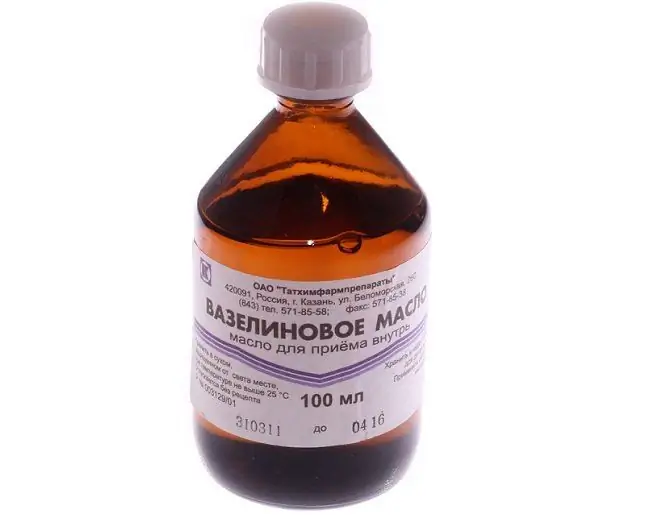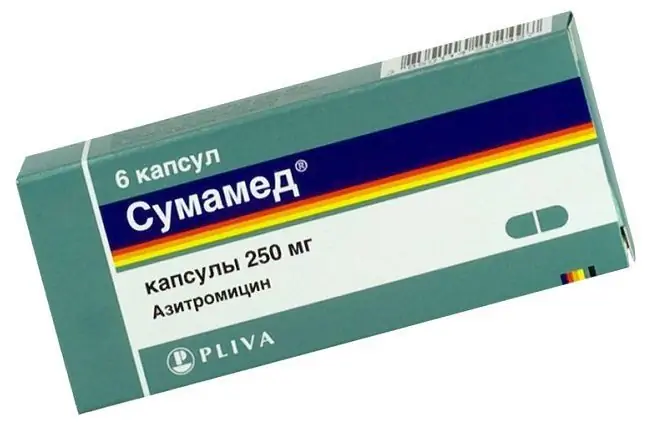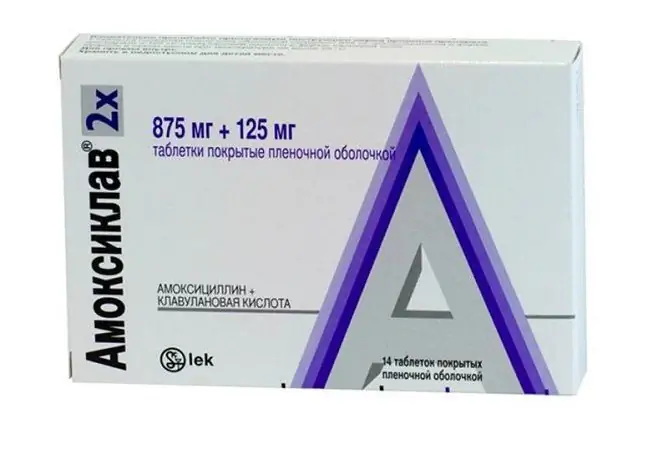- Author Rachel Wainwright [email protected].
- Public 2023-12-15 07:39.
- Last modified 2025-11-02 20:14.
Picodinar
Pikodinar: instructions for use and reviews
- 1. Release form and composition
- 2. Pharmacological properties
- 3. Indications for use
- 4. Contraindications
- 5. Method of application and dosage
- 6. Side effects
- 7. Overdose
- 8. Special instructions
- 9. Application during pregnancy and lactation
- 10. Use in childhood
- 11. In case of impaired renal function
- 12. Use in the elderly
- 13. Drug interactions
- 14. Analogs
- 15. Terms and conditions of storage
- 16. Terms of dispensing from pharmacies
- 17. Reviews
- 18. Price in pharmacies
Latin name: Picodinar
ATX code: A06AB08
Active ingredient: sodium picosulfate (Sodium picosulfate)
Manufacturer: LLC "Grotex" (Russia)
Description and photo update: 2019-18-11
Prices in pharmacies: from 200 rubles.
Buy

Picodinar is a laxative.
Release form and composition
The drug is released in the form of drops for oral administration: a slightly viscous, transparent, slightly colored or colorless liquid (10, 15, 20, 25, 30 or 40 ml each in a bottle with a polyethylene dropper and a lid with a first opening control, in a cardboard box 1 bottle and instructions for use of Pikodinar).
1 ml drops contain:
- active substance: sodium picosulfate monohydrate - 7.5 mg;
- additional components: sodium citrate dihydrate, liquid sorbitol (not crystallizing), anhydrous citric acid, sodium benzoate, sodium hydroxide solution 10M, water for injection.
Pharmacological properties
Pharmacodynamics
Sodium picosulfate belongs to the intestinal motility stimulants of the triarylmethane group. Being a local laxative, the drug, after bacterial cleavage in the large intestine, helps to activate the mucous membrane of the latter, increasing peristalsis, and leads to the accumulation of electrolytes and water in the large intestine. These effects cause stimulation of the act of defecation, a decrease in the evacuation period and softening of feces.
Pikodinar, acting at the level of the large intestine, provides a natural course of evacuation of contents from the lower gastrointestinal tract (GIT). As a result, sodium picosulfate does not interfere with the digestion or absorption of essential nutrients from food into the small intestine.
Pharmacokinetics
The absorption of the drug is insignificant, since it undergoes almost completely metabolic transformation in the intestinal wall and liver, as a result of which it is converted into an inactive glucuronide. Since sodium picosulfate, after oral administration, enters the large intestine and is absorbed in minimal amounts, its enterohepatic circulation can be excluded. After the cleavage of the active substance in the distal part of the large intestine, an active metabolite is formed - bis- (p-hydroxyphenyl) -pyridyl-2-methane. The release rate of this metabolite determines the period of development of the laxative effect, which can be from 6 to 12 hours.
A small amount of sodium picosulfate is detected in the systemic circulation. No relationship was found between the serum concentration of the active metabolite in the blood and its laxative effect. After oral administration of Pikodinar at a dose of 10 mg, approximately 10.4% of the administered dose is excreted after 48 hours in the form of glucuronide. When higher doses of the drug are used, renal excretion ultimately decreases.
Indications for use
Pikodinar is recommended for use as a laxative for the following diseases:
- constipation associated with hypotension and atony of the large intestine (including in elderly patients, bedridden patients, in patients after surgery, after childbirth and during lactation);
- constipation due to the use of drugs;
- gallbladder disease, irritable bowel syndrome with a predominance of constipation;
- hemorrhoids, proctitis, anal fissures - in order to regulate the stool (softening the consistency of feces);
- constipation caused by dietary disorders, intestinal dysbiosis.
Contraindications
Absolute:
- acute inflammatory bowel disease;
- obstructive bowel disease or intestinal obstruction;
- intense abdominal pain or acute lesions of the abdominal organs, which can occur with fever, nausea, vomiting (including appendicitis);
- severe dehydration;
- pregnancy (I trimester);
- intolerance to fructose (since Picodinar contains sorbitol);
- hypersensitivity to any constituent of the laxative.
Relative contraindications, conditions / diseases in which Pikodinar drops should be used with caution: severe renal failure, increased blood magnesium levels, hypokalemia, asthenia, old age.
Pikodinar, instructions for use: method and dosage
Pikodinar drops are taken orally.
Recommended daily doses depending on the age of the patients:
- adults, adolescents and children over 10 years of age: 5-10 mg (10-20 drops);
- children 4-10 years old: 2.5-5 mg (5-10 drops);
- children under 4 years of age: 0.25 mg per 1 kg of body weight, i.e. 0.5 mg (1 drop) per 2 kg of the child's weight.
Children from 4 years of age and adults should start taking the drug at the lowest recommended dose. In order to achieve regular stool, you can increase the daily dose without exceeding the maximum recommended dosage of Pikodinar.
In order to obtain a laxative effect in the morning hours, the drug should be taken the night before.
Before taking the drops, you can not dilute them in liquid. For more accurate dosing of the drug, the bottle should be held vertically.
Side effects
With short-term use of Pikodinar, adverse events are rarely recorded.
Against the background of long-term therapy with the drug in significantly increased doses, the following side reactions may occur:
- metabolism: with an unknown frequency - increased excretion of potassium, sodium and other electrolytes, possible dehydration;
- skin and subcutaneous tissues: with an unknown frequency - skin rash, itching, urticaria;
- immune system: with an unknown frequency - allergic reactions, allergic dermatitis, angioedema;
- nervous system: infrequently - dizziness; with an unknown frequency - drowsiness, increased fatigue, headache, fainting, convulsions;
- Gastrointestinal tract: very often - diarrhea; often - dyspeptic symptoms, flatulence, cramps and abdominal pain; infrequently - vomiting, nausea; with an unknown frequency - pain in the epigastrium and perianal region, increased intestinal motility (disappear with a decrease in the dose of the drug).
Overdose
Due to the intake of high doses of sodium picosulfate, the following disorders may occur: dehydration, decreased blood pressure (BP), hypokalemia, diarrhea, imbalance in water and electrolyte balance, convulsions. Also, cases of ischemia of the muscles of the large intestine have been recorded, caused by the use of doses of Pikodinar, which are much higher than the recommended ones.
Against the background of a chronic overdose of sodium picosulfate, as well as other laxatives, the development of pain in the abdomen, chronic diarrhea, hypokalemia, urolithiasis, secondary hyperaldosteronism is likely. There may also be damage to the renal tubules, due to hypokalemia, muscle weakness, metabolic alkalosis.
In order to reduce the absorption of Pikodinar after oral administration of high doses, induction of vomiting or gastric lavage is recommended. If necessary, the restoration of fluid volume, correction of electrolyte disturbances, the use of antispasmodics are shown.
special instructions
Pikodinar should not be taken daily for more than 10 days without consulting your doctor. If it is necessary to constantly take laxatives, it is required to establish the cause of constipation.
A long course of drug treatment can cause hypokalemia and disturbances in water and electrolyte balance, as well as lead to addiction and constipation resulting from the rebound effect.
Against the background of conditions associated with a violation of the water-electrolyte balance (including with severe impaired renal function), the drug should be taken under medical supervision.
While taking Pikodinar, cases of dizziness and / or fainting were recorded. Analysis of these cases showed that they are associated with fainting during bowel movements, or fainting due to stress during bowel movements, or caused by a vasovagal reaction to abdominal pain due to constipation and possibly not associated with taking the drug.
Picodinar has been shown to be effective in relieving constipation in cancer patients using high-dose opioids.
The effect of the drug on fertility has not been studied. In the process of preclinical studies, no teratogenic effect of Pikodinar on reproductive function was revealed.
Since the laxative has a neutral taste, it is allowed to be added to food for children.
Influence on the ability to drive vehicles and complex mechanisms
Special studies to study the effect of Pikodinar on the ability to drive a car and control complex equipment have not been conducted. However, during the treatment period, the risk of dizziness and / or syncope during intestinal spasm (due to a vasovagal reaction) should be considered. If abdominal spasm occurs in patients, they need to avoid driving vehicles or working with other potentially dangerous and complex mechanisms.
Application during pregnancy and lactation
Taking the drug in the first trimester of pregnancy is contraindicated.
There are no data on reliable and adequate studies in pregnant women. Long-term experience with the drug indicates that it does not have a negative effect on pregnancy. Take Pikodinar in the II and III trimesters of pregnancy, like other laxatives, is allowed only on the recommendation of a doctor.
The active metabolite of sodium picosulfate and its glucuronides are not excreted in breast milk, therefore Pikodinar can be used during breastfeeding.
Pediatric use
The use of the drug in children is possible only as directed by the attending physician, subject to the recommended dosage regimen of Pikodinar.
With impaired renal function
In the presence of severe renal failure, therapy with Pikodinar is required only under medical supervision.
Use in the elderly
Elderly patients should take Pikodinar with caution.
Drug interactions
- cardiac glycosides: there may be an increase in sensitivity to these drugs due to an electrolyte imbalance that occurs while taking sodium picosulfate;
- antibiotics: a decrease in the laxative effect of Pikodinar is possible;
- glucocorticosteroids (GCS), diuretics: the risk of hypokalemia may be aggravated when these agents are combined with sodium picosulfate in high doses.
Analogs
The analogues of Pikodinar are Guttalax, Guttasil, Laxigal-Teva, Sodium picosulfate, Regulax Picosulfate, Slabilen, Slabikap, etc.
Terms and conditions of storage
Store at a temperature not exceeding 25 ° C, out of the reach of children.
The shelf life is 3 years.
Terms of dispensing from pharmacies
Available without a prescription.
Reviews about Pikodinar
The few reviews about Pikodinar found on specialized sites mainly indicate the effectiveness of the drug in the treatment of constipation of a various nature. Drops show a good laxative effect in case of problems with defecation caused by drugs, constipation with hemorrhoids, after surgery, childbirth, as well as chronic constipation in the elderly (including in a severe form). The advantages of the remedy also include the possibility of its use during pregnancy (except for the first trimester), during breastfeeding and in children, including newborns.
However, some patients report severe cramps, abdominal pain and diarrhea that occur after taking the drug.
Price for Picodinar in pharmacies
The price of Pikodinar, drops for oral administration (7.5 mg / ml), can be: for 15 ml in a bottle - 200 rubles, for 30 ml in a bottle - 330 rubles.
Pikodinar: prices in online pharmacies
|
Drug name Price Pharmacy |
|
Pikodinar 7.5 mg / ml drops for oral administration 15 ml 1 pc. RUB 200 Buy |
|
Pikodinar 7.5 mg / ml drops for oral administration 30 ml 1 pc. 330 RUB Buy |
|
Pikodinar drops for internal approx. 7.5 mg / ml vial 30ml 354 r Buy |

Maria Kulkes Medical journalist About the author
Education: First Moscow State Medical University named after I. M. Sechenov, specialty "General Medicine".
Information about the drug is generalized, provided for informational purposes only and does not replace the official instructions. Self-medication is hazardous to health!






